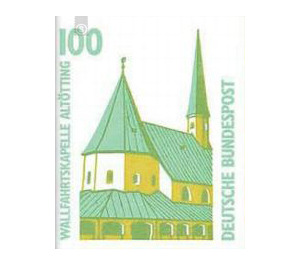Postage stamps: sights - self-adhesive - Germany / Federal Republic of Germany 1991 - 100 Pfennig
Theme: Architecture
| Country | Germany / Federal Republic of Germany |
| Issue Date | 1991 |
| Face Value | 100.00 |
| Color | green white |
| Printing Type | indirect 2-color letterpress |
| Stamp Type | Postage stamp |
| Item Type | Stamp |
| Chronological Issue Number | 1407 |
| Chronological Chapter | GER-BRD |
| SID | 20191 |
| In 50 Wishlists | |
With »Landmarks«, the Deutsche Bundespost replaces the series »Castles and Palaces«, begun in 1976/77. The new permanent series with its unusual representations of significant cultural and technical achievements out, but should also be an incentive to look at the objects once in the original. The supplemental values 10, 60, 80 and 100 Pf for the make mark series appear as self-adhesive stamps in the stamp booklet. The reel stamps appear simultaneously and identically with the inscription "Deutsche Bundespost Berlin". The chapel Altötting is certainly 800 years older than the pilgrimage. The Bavarian dukes built here around 700 an initially simple residence with house church, even recorded here in 748. Next to this church in the area of the Palatinate grew on the green mat alone the ancient holy chapel, a baptismal house according to custom and style as a round chapel. Its interior is extended through eight niches, one containing the altar with a statue of Our Lady. Outside, the sanctuary was raised by a gothic pointed helmet and girded with a laid-back handling. At the beginning of the pilgrimage, it was enlarged by adding a long house. The place itself had become quiet. The Bavarian dukes had been deposed in 788, the Carolingian princes, also king and emperor, had indeed rebuilt the residence, including a basilica of 877, so large that they and their staff could celebrate Christmas and Easter here. But the Hungarian storms around 900 devastated everything. Preserved were probably stone walls, while the ancient holy chapel. The Wittelsbach brought back life, a new Palatinate with a new church and a canon. But world-moving things no longer stirred in the poor village of the abbey. In it, in 1489, the Miraculum, the miracle, flashed. One boy, drowned in the brook, another, crushed by the harvest-wagon, came to life again after invoking Our Lady. Historically, the events are not to be doubted. That, according to modern wisdom, they hardly broke the laws of nature is not decisive. The confidence of the faithful grew in them. In no time, the news ran through the country; Already in the first decades pilgrims came from all over Bavaria, Austria, Tyrol, Franconia and Rhineland, individually and in groups. The attractions of Altötting: - The image of grace of about 1330, simple pious Gothic, the "black Madonna", darkened by candle smoke and oxidation of the socket, dressed as early as 1518 by princely hands with precious material, gold and precious stone, crowned with princely and imperial crown - The "Ancient Holy Chapel", with its touch of Bavarian and even earlier piety, with the real hearts of the kings rescued in silver urns, pious honor guardians at the throne of the Mother of the Land, - The 3,000 votive tablets with their unmistakable statement: Mary has helped will help. They are witnesses to the trust of millions who invite for reflection and trust. The rich Treasury with the Golden Horse, the gifts of worship and gratitude, want the same thing. The grandiose even today is, unlovely, the indestructibility of the pilgrimage. Today there are one million pilgrims per year, foot pilgrims 40,000, 40,000 by rail, 200,000 by bus, more than 500,000 by car, plus the uncounted winter half. If some people do not focus on the religious experience, the whole thing is a lively and powerful block of religious events. Thus, Altötting can honestly and proudly celebrate a 500th anniversary of the pilgrimage. (Text: Bavarian Ministry of Economic Affairs and Transport, Munich)


